![Bold Solutions Make Real Cities More Efficient Bold Solutions Make Real Cities More Efficient [Interactive]](assets/ecity-updated.jpg)
![Bold Solutions Make Real Cities More Efficient Bold Solutions Make Real Cities More Efficient [Interactive]](assets/ecity-updated.jpg)
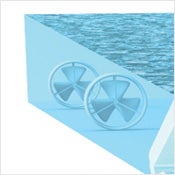 (New York City)
(New York City)
Turbines on the seafloor or estuary beds are turned by daily tides, generating electricity. After successfully operating six turbines in an array on the bottom of the East River along Manhattan, Verdant Power is now awaiting a license to install 30 turbines that could generate one megawatt of power.
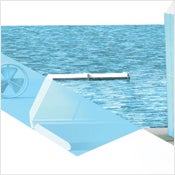 (Orkney, Scotland)
(Orkney, Scotland)
Hinged cylinders anchored in the seafloor are pushed by waves, turning onshore turbines that create electricity. Aquamarine Power and Queens University Belfast have [operated one unit] off the coast of Orkney, and are now engineering a second-generation machine.
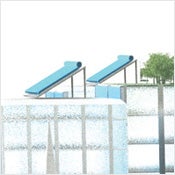 (Rizhao, China)
(Rizhao, China)
Water-filled tubes connected to tanks on roofs are heated by the sun to provide domestic hot water instead of furnaces. In Rizhao, nearly all new buildings in the fast-growing city [have rooftop systems] that provide hot water for bathing. The systems cost around $200. In the U.S., hot water accounts for 17 percent of energy used by homes.
 (Berlin)
(Berlin)
This technology is still in its early days, but photovoltaic sheets on south-facing building facades can generate significant electricity. One notable demonstration [is in Berlin], built by a German firm originally called Sulfurcell but now named [Soltecture]. Thin-films typically are less efficient than solar cells, but they can be cheaper to make and are flexible, leading to novel installations.
 (Ontario and Redlands, Calif.)
(Ontario and Redlands, Calif.)
Panels generate electricity in lieu of power plants doing so, and also shade rooftops to lower a building's cooling needs. Together, Ontario and Redlands, working with the Southern California Edison utility, have erected seven ["neighborhood power stations"] on large industrial rooftops, totaling 306,500 square meters.
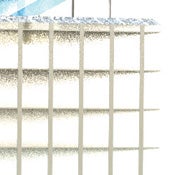 (Empire State Building, New York City)
(Empire State Building, New York City)
Superinsulated windows quadruple the thermal performance of double panes and can be made from the glass in existing windows. Workers from Serious Energy reused the glass in all 6,514 windows in the Empire State Building to make [superinsulated windows] that are four times more energy efficient. The retrofit took seven months.
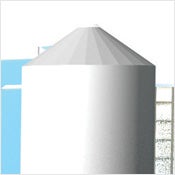 (Under development)
(Under development)
Construction material made locally with carbon dioxide that is pumped out by power plants could reduce greenhouse gas emissions. Calera Corp. is [bubbling the gas from a power plant] in Moss Landing, Calif., through nearby seawater to make cement. The process also eliminates the roughly one ton of emissions that would normally be created in making a ton of cement the conventional way.
 (Under development)
(Under development)
Food grown indoors could reduce fertilizer and freshwater use, shorten transportation routes for delivery, and recycle gray water otherwise dumped by city treatment plants. [Designs already exist] for entire high-rise farms, yet enclosed rooftop farms above restaurants, schools, hospitals or other institutions that serve many meals might be the first incarnations of a coming urban trend.
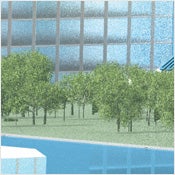 (Chicago)
(Chicago)
Rooftop vegetation insulates buildings against heat and cold and absorbs storm water that could otherwise pollute waterways. Many cities are pursuing these roofs, and friendly competitions for the most square feet of green roofing have arisen among Chicago, New York, Washington, D.C., and others. Trade associations and design awards have helped [spur a burgeoning industry] of green rooftop builders.
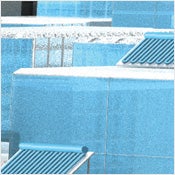 (Washington, D.C.)
(Washington, D.C.)
Rooftops painted white reflect heat, lowering a building's cooling cost and a city's heat buildup. U.S. Secretary of Energy Steven Chu [put the technique on the front burner] in 2009 when he gave a speech extolling white roofs as an inexpensive move that can be done quickly and provide immediate payoff.
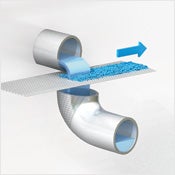 (Nashville, Tenn; Buffalo, N.Y.)
(Nashville, Tenn; Buffalo, N.Y.)
Solid waste extracted from sewage at treatment plants is [burned to make electricity]. When cities process so-called black water (from toilets and things), they typically separate and incinerate the solids, but adjustments to the furnaces can turn them into part of a system that generates electricity.
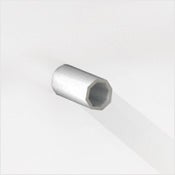 (London)
(London)
Tunnels dedicated to carrying electricity, water, cable television and broadband Internet minimize damage from storms and make repairs easier. Many cities sequester some of their utilities underground, but London excels at this approach and [has done so since 1861] when engineers built several miles of tunnels for running gas and hydraulic power pipes.
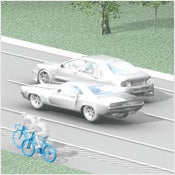 (San Francisco; New York City)
(San Francisco; New York City)
Large portions of taxi fleets converted to hybrid vehicles reduce air pollution and greenhouse gas emissions. After New York City Mayor Michael Bloomberg had encouraged fleets to purchase hybrids, and many did, his administration tried to penalize owners who didn't switch, but courts struck down the policy. Nevertheless, about [4,300 of the city's yellow cabs are now hybrids], one third of the total.
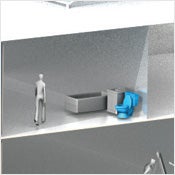 (San Francisco; New York City)
(San Francisco; New York City)
(Austin, Texas)
Water-saving toilets and showerheads installed in new and existing buildings save millions of gallons annually. Austin began a retrofit program years ago that has left most of the city with low-flow devices, [reducing water usage] (pdf) by 19 million liters a day and wastewater flows by 680,000 liters daily.
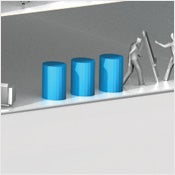 (San Francisco)
(San Francisco)
Requiring businesses and homes to separate refuse spares landfills. San Franciscans [use three garbage bins]: recyclables (papers, bottles, cans and plastics), compost (food scraps, soiled paper) and trash (the rest). The city charges residents for collection based on the volume in the trash bin, not the others, which encourages compliance.
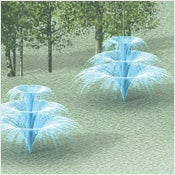 (Los Angeles)
(Los Angeles)
Satellite control of park and lawn irrigation systems cuts water consumption and pumping power. Municipalities subscribe to a service provided by companies such as HydroPoint Data Systems, which [forecast weather and soil moisture] for each part of a client's property or properties and turns portions of the irrigation systems on or off accordingly, greatly reducing wasted watering and lowering water bills.
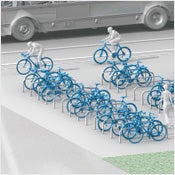 (Minneapolis)
(Minneapolis)
Ample bike lanes and bike racks encourage more people to ride instead of drive; they also promote health. These straightforward steps can make a huge difference. Despite its long, cold winters, Minneapolis has been ranked as [the best cycling city in the country] by Bicycling magazine, largely because such measures have encouraged many riders, even when the mercury dips low.
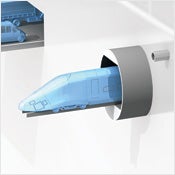 (Portland, Ore.)
(Portland, Ore.)
Commuter trains, subways and primary roads are located underground in massive tunnels, freeing the surface for easy, clean bike and pedestrian traffic. Many cities have miles of, [subterranean transportation] but Portland [is diverting such traffic] as part of an integrated overhaul plan to encourage more walking, biking and the redesign of public spaces.
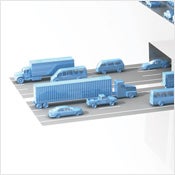 (Stockholm; Singapore)
(Stockholm; Singapore)
Charging drivers higher rates to drive in congested neighborhoods eases traffic. By the end of a [six-month trial in Stockholm], traffic had dropped by 25 percent, emissions decreased 14 percent, 40,000 more people daily were taking public transit, whereas buses were reaching their stops quicker. The Stockholm Congestion Charging System is now permanently in place.
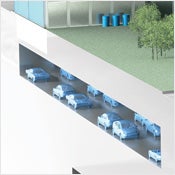 (Paris)
(Paris)
Subterranean garages near commuter destinations eliminate the need for cars to surface. Many cities have had enough foresight to build at least some underground parking but [Paris stands out]. Drivers are encouraged to use the lots with fees that are typically lower than for aboveground spots, and the lower levels are monitored by security cameras, so they are considered safer than city streets.
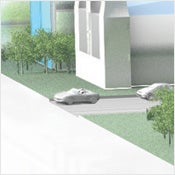 (San Francisco)
(San Francisco)
Digital parking meters tell mobile-phone and navigation apps [when a space opens up], reducing traffic caused by drivers trolling for spaces. A free [iPhone application and Web site] made available in April by San Francisco's transportation agency also tells drivers how much parking will cost. So far, the project covers 7,000 of the city's 28,800 metered parking spaces.
(Rockville, Md.)
Residential and commercial construction done across a city region to the highest green, or leadership in energy and environmental design (LEED), standards saves energy, water, materials and emissions. LEED has become well known for encouraging architects to design buildings that achieve these goals, but the advisory group has now devised approaches for developers to engineer [entire town sections[OR: neighborhoods]] to achieve similar gains.
(Philadelphia)
[Taxing property owners] on the volume of storm water that runs off their property promotes retrofits that reduce wastewater volume at city treatment plants. Owners can reduce their runoff in many ways, including rain catch-basins or barrels, retention ponds, swales that allow water to soak into the earth, green roofs that absorb water and more.
(Rotterdam; London)
Open gates in rivers, estuaries and canals close when storm surges are expected to prevent extensive property damage and protect low-lying and subterranean infrastructure. The Netherlands has [several world-class designs] in place, particularly around Rotterdam. London has [a different scheme].
Gates are only beginning to be erected around New Orleans, but if a proposed grand plan is pursued [many more would be built].
X